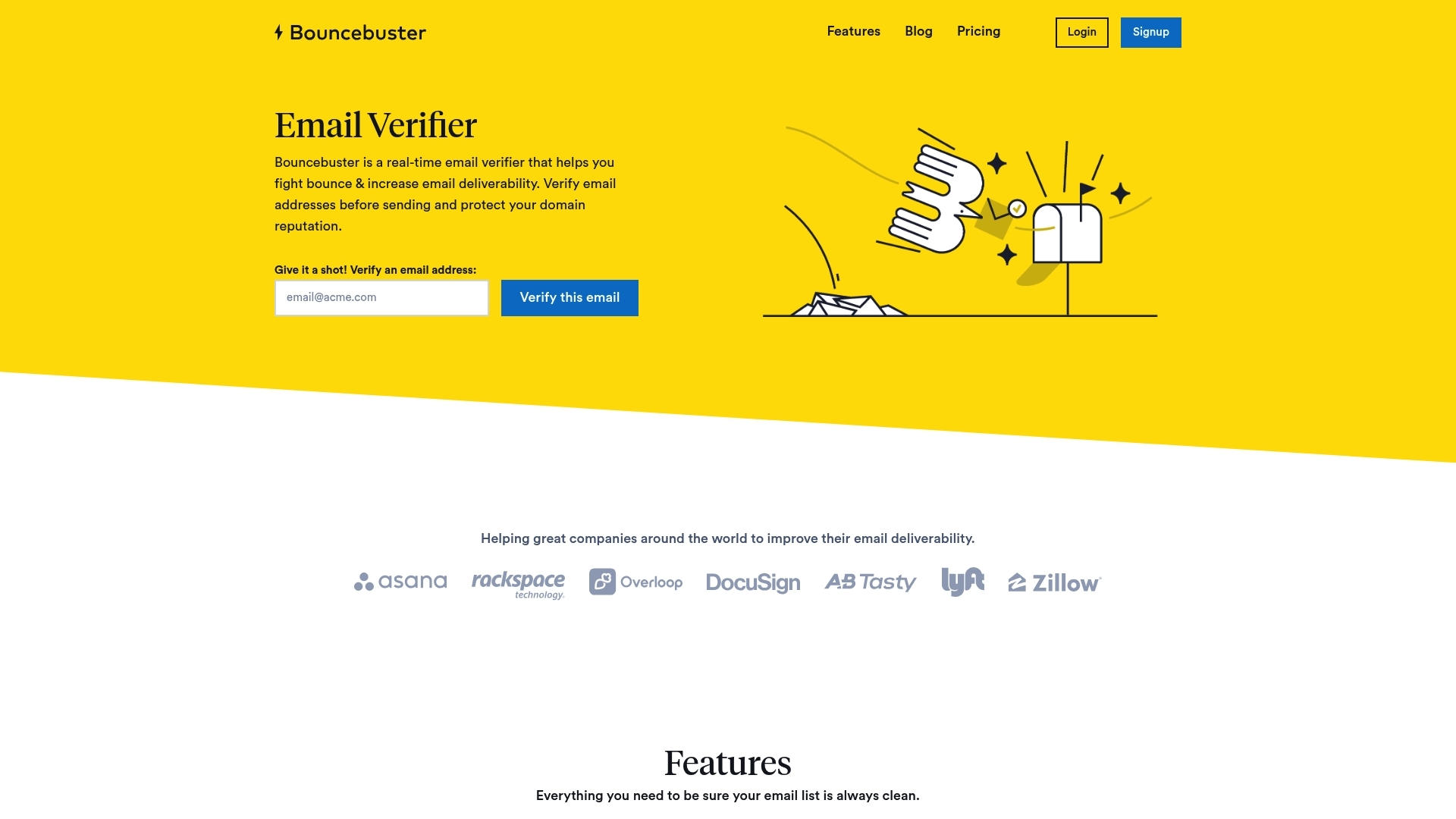Email bounce rate solutions: exploring real case studies
Email bounce rates represent the percentage of emails that fail to deliver to recipients' inboxes. Such bounces can severely impact the effectiveness of marketing campaigns, leading to wasted resources and potential revenue loss. Hard bounces occur with invalid emails, while soft bounces typically involve temporary server issues. Addressing these issues is crucial.
Why Focus on Email Bounce Rates?
- Reduced Deliverability: High bounce rates can damage sender reputation, leading to emails landing in spam folders rather than inboxes.
- Wasted Resources: Failed emails mean wasted marketing efforts and expenditures.
- Lost Engagement: Each bounced email represents a missed opportunity to engage with your audience.
Effective Email List Management
Effective strategies involve regular list cleaning and verification to maintain a high-quality subscriber base. This process ensures that businesses communicate only with valid emails, enhancing overall deliverability.
Solutions like BounceBuster offer tools to efficiently verify and clean email lists, minimizing bounce rates. By employing such tools, marketers can optimize their campaigns to achieve better outcomes, ensuring each email reaches its intended recipient smoothly.
the role of tools in reducing email bounce rate
Reducing email bounce rates effectively requires using specialized tools designed to streamline email list management. An email bounce occurs when messages fail to deliver to recipients' email addresses. This can be due to invalid addresses, full inboxes, or server issues. Tools like BounceBuster play a crucial role in mitigating such rates, ensuring that your messages reach the intended inboxes.
Email Verification Tools
Email verification tools examine email lists to identify and remove invalid or risky email addresses. By doing so, these tools help maintain the cleanliness and accuracy of email data, which is key to marketing campaign success. Clean lists result in higher deliverability rates, meaning more emails reach recipients without bouncing.
Some key features of email verification tools include:
- Bulk Email Verification: Uploading large files like CSV or XLS to verify multiple email addresses at once.
- Manual Checks: Verifying individual email addresses when needed.
- API Integration: Seamlessly integrating with existing systems to allow real-time verification and monitoring.
Advantages of Using Email Verification Tools
- Increased Deliverability: Guaranteed higher chances that emails will reach the inbox rather than the spam folder.
- Cost Efficiency: Reduces wasted resources by ensuring only valid emails are contacted.
- Improved Sender Reputation: Clean and verified lists enhance sender's email credibility, thus reducing blacklist chances.
BounceBuster's Unique Approach
BounceBuster provides a comprehensive solution with powerful features like bulk verification and easy API integration. Whether businesses opt for uploading email lists in bulk or need APIs for real-time checks, BounceBuster supports different methods for enhancing email deliverability. With its seamless integration capabilities and upcoming CRM tool connections, it offers flexibility and efficiency in maintaining low bounce rates.
By integrating such tools into their email strategy, marketers can focus on engaging content and strategy, knowing their messages will be more likely to land in recipients' inboxes. This proactive approach not only safeguards sender reputation but also enhances campaign effectiveness, ensuring better overall results.
case study 1: company a's success with BounceBuster

Problem Identification
- Outdated Email Lists: Large portions of email lists contained invalid addresses or non-existent domains, contributing to high bounce rates.
- Poor Deliverability: High bounce rates affected overall deliverability, leading to emails being marked as spam.
- Resource Inefficiency: Continued sending to non-responsive addresses wasted time and marketing resources.
Solution Implementation
To tackle these issues, Company A decided to integrate BounceBuster into their marketing strategy. The implementation process involved several pivotal steps:
- Bulk Email Verification: Company A uploaded their entire email database using BounceBuster's CSV file feature to verify and clean their lists.
- Real-time Validation: Utilized BounceBuster's manual verification tool for daily checks on new subscribers, ensuring only valid emails entered their list.
- Integration with Marketing Tools: Leveraged BounceBuster's upcoming integrations to seamlessly fit verification into their existing CRM systems.
Results Achieved
The outcomes of Company A's modifications were impressive and swift:
- Reduced Bounce Rate: Company A achieved a 40% reduction in bounce rates within the first month of using BounceBuster.
- Improved Deliverability: Enhanced sender reputation led to a noticeable increase in emails reaching the primary inbox instead of spam folders.
- Increased Engagement: With clean, effective lists, Company A saw a 25% increase in open and click-through rates, driving better customer interaction and conversion rates.
Harnessing the capabilities of BounceBuster, Company A transformed their email marketing efforts. By focusing on clean data and proactive list management, they not only addressed the problem of high bounce rates but significantly improved their overall campaign performance. This case illustrates the effectiveness of adopting specialized tools and vigilant email list scrutiny in achieving email marketing success.
case study 2: company b's email strategy transformation
Handling an escalating email bounce rate crisis, Company B sought a systematic approach. They aimed to overhaul their strategy by combining technology and strategic planning for improved communication efficiency.
Initial Challenges and Strategy
Company B dealt with high bounce rates that undermined their email marketing efforts. Many issues stemmed from outdated and incorrect subscriber information, which disrupted campaign performance and strained marketing resources.
Steps to Overcome High Bounce Rates
- Comprehensive Analysis: Company B first conducted a thorough analysis of their existing email list. Identifying invalid and stale addresses was crucial.
- Tool Integration: They adopted tools that provided email verification and list management, helping them streamline the data cleansing process.
- Strategic Emailing: Beyond technical checks, they implemented a strategy to re-engage inactive subscribers, ensuring only interested recipients remained on their list.
- Personalization and Content Adjustments: Modifying email content to suit different segments improved engagement, reducing the likelihood of emails being marked as spam.
Implementation of Solutions
Company B's transformation process involved utilizing key tools for verification and adopting a refreshed approach to list management. They moved from sporadic verifications to consistent and routine checks, ensuring ongoing email list accuracy.
Effectiveness of Changes
- Reduced Bounce Rates: Within months, Company B observed a significant dip in bounce rates. Their email campaigns reached more active users and potential leads.
- Improved Engagement: Personalized strategies resulted in higher open rates and interaction as messages resonated better with their audience.
- Cost Efficiency: By pruning their list and focusing on quality contacts, Company B optimized expenditure on email campaigns, improving return on investment.
Company B’s story highlights how a blend of strategic planning and technology can tackle email bounce rate issues. By integrating email verification tools, businesses can fortify their communication channels, ensuring that their marketing materials not only reach the inbox but also make an impact. Solutions like BounceBuster exemplify the kind of tools essential in this transformation, assisting companies just like Company B in maintaining a healthy email list and achieving marketing success. Through a disciplined approach and diligent use of advanced tools, Company B successfully turned their emailing strategy into a powerful marketing asset.
comparing results: BounceBuster vs. other solutions
To understand how BounceBuster compares to other email verification and list management solutions, we first need to look at what it brings to the table versus its competitors.
BounceBuster: What Sets It Apart?
BounceBuster offers several core features that contribute to its effectiveness:
- Bulk Email Verification: Supports CSV or XLS uploads to handle large volumes efficiently.
- Real-time API Integration: Allows seamless integration with existing marketing and CRM tools.
- Upcoming CRM Tool Connections: Developments to further integrate within existing systems.
These features are designed to streamline the email list cleaning process, enhancing email deliverability.
Other Solutions: Features and Limitations
Other popular tools also offer useful functionality, but they vary in terms of capacity, integration, and added benefits:
- Tool A: Offers robust verification capabilities similar to BounceBuster but lacks seamless API integration capability.
- Tool B: Provides extensive analytics but is more complex to set up, which may not suit businesses seeking simple solutions.
- Tool C: Offers competitive pricing but limits batch verification size, potentially affecting large-scale operations.
Comparative Analysis: BounceBuster Success vs. Other Solutions
The case studies explored indicate that implementing BounceBuster led to significant improvements in email performance metrics:
| Criterion | BounceBuster | Other Tools |
|---|---|---|
| Ease of Use | Simple setup, intuitive dashboard | Varies; often complex |
| Scalability | Efficient bulk processing | Often limited |
| Integration | Smooth API support, CRM integrations | Often partial or absent |
| Results | 40% bounce rate reduction in a month | Varies, typically less |
Overall, while other tools provide useful services, BounceBuster offers a unique combination of ease of use, scalability, and integration capabilities. Users can expect substantial bounce rate reductions aligning with real-world results experienced by Company A, as illustrated in previous sections. This distinction makes BounceBuster an appealing choice for businesses aiming for high deliverability and session efficiency in their email marketing campaigns.
best practices for maintaining low email bounce rates
Maintaining a low email bounce rate is essential for effective email marketing. The insights from our case studies highlight several best practices that businesses can adopt to achieve this.
Regular Email List Verification
Consistently verify your email lists to identify invalid or potentially risky email addresses. Tools such as BounceBuster simplify this process with features like bulk email verification and API integration, ensuring that your lists remain clean and optimized for higher deliverability.
Implement Double Opt-In Procedures
Utilize a double opt-in process to confirm email subscriptions. This approach adds an extra layer of verification, as subscribers must confirm their email addresses before receiving communications, reducing hard bounces caused by invalid addresses.
Monitor Engagement Levels
Regularly assess your email engagement levels. Identify and remove subscribers who consistently do not open or engage with your emails. Doing so minimizes soft bounces, improves inbox placement, and enhances sender reputation.
Keep Your Content Relevant and Personalized
Craft emails that are relevant to your audience's interests. Use personalization techniques to tailor content, ensuring it resonates with the individual recipient. This approach not only reduces the likelihood of emails being marked as spam but also encourages higher open rates.
Perform Routine Email Hygiene
Establish a routine for email list cleaning. Remove duplicate entries, correct obvious typos in domain names, and ensure data is up-to-date. This practice maintains list integrity and optimizes delivery rates.
Analyze and Adapt to Trends and Feedback
Stay attuned to industry trends and feedback from your email campaigns. Regular analysis allows you to adjust strategies and implement new tactics, led by real-world performance insights.
By incorporating these strategies into your email marketing efforts, businesses can maintain lower bounce rates, ensuring their messages effectively reach their audience and foster meaningful interactions.
quick summary of key insights
Throughout the article, we've explored effective strategies and tools designed to reduce email bounce rates, focusing on solid real-world applications.
Key Insights and Tools
-
Email Bounce Rate Challenges: Businesses grapple with bounce rates that harm marketing strategies due to outdated email lists and inefficient list management.
- High bounce rates can sabotage sender reputation, reduce deliverability, waste resources, and result in lost engagement.
-
Tools and Solutions: Employing tools like BounceBuster is pivotal:
- Email Verification: These tools verify and clean email lists to improve deliverability.
- API Integration: Allows seamless incorporation into existing workflows, ensuring real-time accuracy.
Success Stories from Case Studies
-
Company A's Success:
- Leveraged BounceBuster to achieve a 40% reduction in bounce rates.
- Enhanced sender reputation and improved customer engagement by utilizing bulk verification and manual checks.
-
Company B's Transformation:
- Combined strategic approaches with email verification tools to decrease bounce rates significantly.
- Improved engagement rates through personalization and targeted re-engagement strategies.
Comparative Analysis
- BounceBuster displays superiority over other solutions in key areas like scalability, ease of use, and integration capabilities.
- This effectiveness is illustrated through the noticeable improvements seen in Company A's reduced bounce rates and better email deliverability.
In summary, businesses stand to benefit greatly from diligent email list management and the deployment of effective verification tools. A proactive approach in ensuring clean and valid subscriber data can lead to substantial improvements in marketing campaigns, as demonstrated by the included case studies.
faq on email bounce rate solutions
When it comes to managing email campaigns, understanding and addressing the intricacies of email bounce rates is essential. Common questions often arise around this topic, seeking clarity on the best practices and tools available to maintain a healthy email architecture. Let’s discuss these questions, leveraging insights from our previous sections about strategies for reducing email bounce rates.
What is an Email Bounce Rate?
An email bounce rate refers to the percentage of emails that fail to reach the recipient's inbox. This can significantly affect how successful a marketing campaign is. Distinguishing between hard and soft bounces helps clarify the nature of these delivery failures:
- Hard Bounce: This occurs when an email is returned due to permanent reasons such as an invalid recipient address.
- Soft Bounce: Temporary issues like a full inbox or server problems cause these.
How Can I Reduce My Email Bounce Rates?
Reducing bounce rates involves a combination of strategies:
- Regular List Cleaning: Utilize tools like BounceBuster for regular email verification, ensuring that only valid and active addresses are part of your campaigns.
- Double Opt-In: Implementing a double opt-in process ensures recipients really want to receive communications, which helps avoid hard bounces.
- Routine Engagement Monitoring: Track and engage with your audience effectively to limit bounces related to inactive emails.
Are Tools Necessary for Email List Management?
Yes, utilizing specialized tools can make a substantial difference. Such tools automate the verification process, identifying and excluding invalid email addresses efficiently:
- Enhanced Accuracy: Tools automatically spot invalid addresses, preserving list integrity.
- Cost Efficiency: They prevent marketing resources from targeting non-existent recipients.
- Improved Deliverability: Clean lists reduce the likelihood of messages entering spam folders, enhancing sender reputation.
What Benefits Does BounceBuster Offer?
BounceBuster stands out due to its robust verification features:
- Bulk Verification: Process extensive lists at once using easy file uploads.
- API Integration: Connect seamlessly with marketing and CRM systems for real-time verification.
- Upcoming Integrations: Expanding compatibility with more tools to support comprehensive marketing efforts.
Why Monitor Email Bounce Rates Regularly?
Regular monitoring allows for swift action and adaptation:
- Performance Insight: Understanding bounce rates provides insight into campaign effectiveness and subscriber behavior.
- Reputation Management: Continual evaluation avoids negative impacts on sender reputation, which could affect the entire organization's email deliverability.
How Do We Apply Case Study Insights to Our Strategy?
Learning from real-world examples offers practical solutions:
- Adapt Proven Strategies: Reflect on Company A's use of BounceBuster for strategic list cleaning.
- Combine Tools and Strategy: Like Company B, blend technological tools with strategic approaches for holistic solutions.
These questions frame the essential aspects of ensuring low email bounce rates, emphasizing the need for both strategic actions and supportive tools. By understanding and applying these insights, businesses will not only reduce their bounce rates but also enhance their overall email marketing effectiveness. This knowledge serves as a foundation for building robust and efficient email campaigns tailored to each audience's particular needs.



